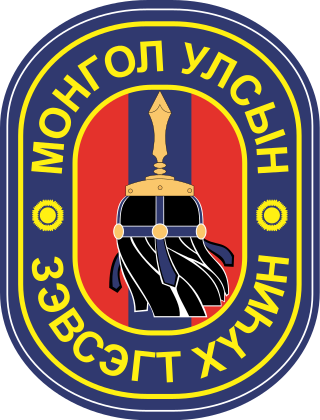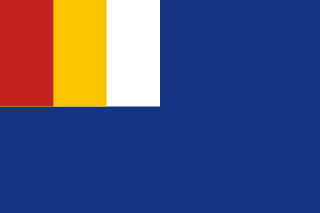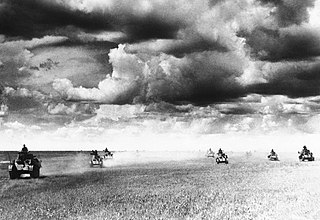Mongolian units are the traditional units of measurement of the Mongolian people.
Mongolian units are the traditional units of measurement of the Mongolian people.
| Mongolian | English transliteration | Equivalent to | In metric system (approximate) |
|---|---|---|---|
| хумсны толио | humsny tolio | width of index finger nail | 1–1.2 cm |
| хуруу | huruu | index finger width | 1.5–2 cm |
| ямх | yamh | length of index finger distal phalanx | 3.5 cm |
| барим | barim | fist width | 8–9 cm |
| мухар сөөм | muhar sööm | distance between stretched thumb and proximal phalanx of index finger | 12–15 cm |
| үзүүр сөөм | üzür sööm | distance between stretched thumb and index finger | 18 cm |
| төө | töö | distance between stretched thumb and middle finger | 19–20 cm |
| мухар тохой | muhar tohoi | distance between elbow and fist | 33 cm |
| үзүүр тохой | üzür tohoi | distance between elbow and middle finger, = 20 huruu | 40 cm |
| алхам | alham | distance of one step | 50 cm |
| дэлэм | delem | distance between outstretched arm and opposite shoulder | 95 cm |
| эгэм | egem | = 1+1⁄2 delem | 1.35 m |
| алд | ald | distance between outstretched arms, = 4 üzür tohoi | 1.6 m |
| гөрөм | göröm | = 2,000 ald | 3 km |
| бээр | beer | = 4 göröm | 12 km |
| өртөө | örtöö | 30 km | |
| хагас өдрийн газар | hagas ödriin gazar | half-day horse ride distance, = 1+1⁄2 örtöö | 40–45 km |
| өдрийн газар | ödriin gazar | one day horse ride distance, = 3 örtöö | 90–100 km |
| хоногийн газар | honogiin gazar | a day and night horse ride distance, = 4 örtöö | 120–130 km |
| Mongolian | English transliteration | In metric system |
|---|---|---|
| пүү | püü | 16.5 kg |
| жин | jin | 596.816 g |
| лан | lan | 37.301 g |
| цэн | tsen | 3.7301 g |

The Mongols are an East Asian ethnic group native to Mongolia, Inner Mongolia in China, and the Buryatia Republic of the Russian Federation. The Mongols are the principal member of the large family of Mongolic peoples. The Oirats in Western Mongolia as well as the Buryats and Kalmyks of Russia are classified either as distinct ethno-linguistic groups or subgroups of Mongols.

Mongolia is a landlocked country in East Asia, bordered by Russia to the north and China to the south. The western extremity of Mongolia is only 37 km (23 mi) from Kazakhstan, and this area can resemble a quadripoint when viewed on a map. It covers an area of 1,564,116 square kilometres, with a population of just 3.3 million, making it the world's most sparsely populated sovereign state. Mongolia is the world's largest landlocked country that does not border a closed sea, and much of its area is covered by grassy steppe, with mountains to the north and west and the Gobi Desert to the south. Ulaanbaatar, the capital and largest city, is home to roughly half of the country's population.

The Mongolian Armed Forces is the collective name for the Mongolian military and the joint forces that comprise it. It is tasked with protecting the independence, sovereignty, and territorial integrity of Mongolia. Defined as the peacetime configuration, its current structure consists of five branches: the Mongolian Ground Force, Mongolian Air Force, Construction and Engineering Forces, cyber security, and special forces. In case of a war situation, the Border Troops, Internal Troops and National Emergency Management Agency can be reorganized into the armed forces structure. The General Staff of the Mongolian Armed Forces is the main managing body and operates independently from the Ministry of Defence, its government controlled parent body.

The Battles of Khalkhin Gol were the decisive engagements of the undeclared Soviet–Japanese border conflicts involving the Soviet Union, Mongolia, Japan and Manchukuo in 1939. The conflict was named after the river Khalkhin Gol, which passes through the battlefield. In Japan, the decisive battle of the conflict is known as the Nomonhan Incident after Nomonhan, a nearby village on the border between Mongolia and Manchuria. The battles resulted in the defeat of the Japanese Sixth Army.

The Khalkha or Kalka have been the largest subgroup of Mongol people in modern Mongolia since the 15th century. The Khalkha, together with Chahars, Ordos and Tumed, were directly ruled by Borjigin khans until the 20th century; unlike the Oirats, who were ruled by Dzungar nobles or the Khorchins, who were ruled by Qasar's descendants.

A league is an administrative unit of the autonomous region of Inner Mongolia in the People's Republic of China.
A sum is an administrative division used in China, Mongolia, and Russia. The word sum is a direct translation of the Manchu word niru, meaning ‘arrow’. Countries such as China and Mongolia have employed the sum as administrative division, which was used during the Qing dynasty. This system was acted in the 1980s after the Chinese Communist Party gained power in conjunction with their growing internal and external problems. The decentralisation of government included restructuring of organisational methods, reduction of roles in rural government and creation of sums.

The Mongolian People's Army, also known as the Mongolian People's Revolutionary Army or the Mongolian Red Army was an institution of the Mongolian People's Revolutionary Party constituting as the armed forces of the Mongolian People's Republic. It was established on 18 March 1921 as a secondary army under Soviet Red Army command during the 1920s and during World War II. In 1992, the army's structure changed and then reorganized and renamed as the Mongolian Armed Forces.

The Inner Mongolian Army, also sometimes called the Mengjiang National Army, referred to the Inner Mongolian military units in service of Imperial Japan and its puppet state of Mengjiang during the Second Sino-Japanese War, particularly those led by Prince Demchugdongrub. It was primarily a force of cavalry units, which mostly consisted of ethnic Mongols, with some Han Chinese infantry formations.
Noyan, or Toyon, was a Central Asian title of authority which was used to refer to civil-military leaders of noble ancestry in the Central Asian Khanates with origins in Noyon, which was used as a title of authority in the Chagatai Khanate of the Mongol Empire. In modern times, Noyan is used as a given name or surname in Asia and throughout Central Asia meaning "the lord", "the prince", "the protector", "the commander-in-chief".

The Soviet–Japanese border conflicts, also known as the Soviet-Japanese Border War or the First Soviet-Japanese War or the Russo-Mongolian-Japanese Border Wars or the Soviet-Mongolian-Japanese Border Wars was a series of minor and major conflicts fought between the Soviet Union, Mongolia and Japan in Northeast Asia from 1932 to 1939.

The Mongolian nobility arose between the 10th and 12th centuries, became prominent in the 13th century, and essentially governed Mongolia until the early 20th century.
The country of Mongolia is divided into 21 provinces and the capital Ulaanbaatar.

The Mongolian Air Force is the aerial warfare service branch of the Mongolian Armed Forces.
The 112th "Revolutionary Mongolia" Tank Brigade, previously the 112th Tank Brigade, was a military formation in the Red Army, funded by contributions from the People's Republic of Mongolia, during World War II. It was originally formed as the 112th Tank Division.
The 12th Motor Rifle Division was a motorized infantry division of the Soviet Army, formed twice. It was formed in 1957 from the 12th Rifle Division and disbanded in 1958. The division was reformed in 1960 and moved to Baganuur in Mongolia in 1979. It pulled out of Mongolia in 1990 and became a storage base in 1992. The storage base was disbanded in 1993.

Outer Mongolia — officially the Mongolian People's Republic — was ruled by the communist government of Khorloogiin Choibalsan during the period of World War II and had close links with the Soviet Union. Most countries regarded Mongolia, with its fewer than a million inhabitants, as a breakaway province of the Republic of China. Throughout the 1941–1945 war between Germany and the Soviet Union, Mongolia provided the Soviets with economic support—such as livestock, raw materials, money, food and military clothing—violating Mongolian neutrality in favor of the Allies. Mongolia was one of two Soviet satellite states not generally recognised as sovereign states at the time, along with the Tuvan People's Republic; both of these republics participated in World War II.

The Yuan of Mengjiang is the monetary unit that was issued in 1937–1945 by several governments of Mengjiang.
Arkhi is a liquor made from airag, fermented milk brandy, or isgelen tarag which then gets distilled. Isgelen tarag often uses the milk of a mare, donkeys, sheep, cows, the yak, camels (specifically, khormog or of reindeer, depending on local traditions or availability. It holds special status in Mongolia and Inner Mongolia, both as the prime spirit of choice among pastoral units and served to esteemed guests.